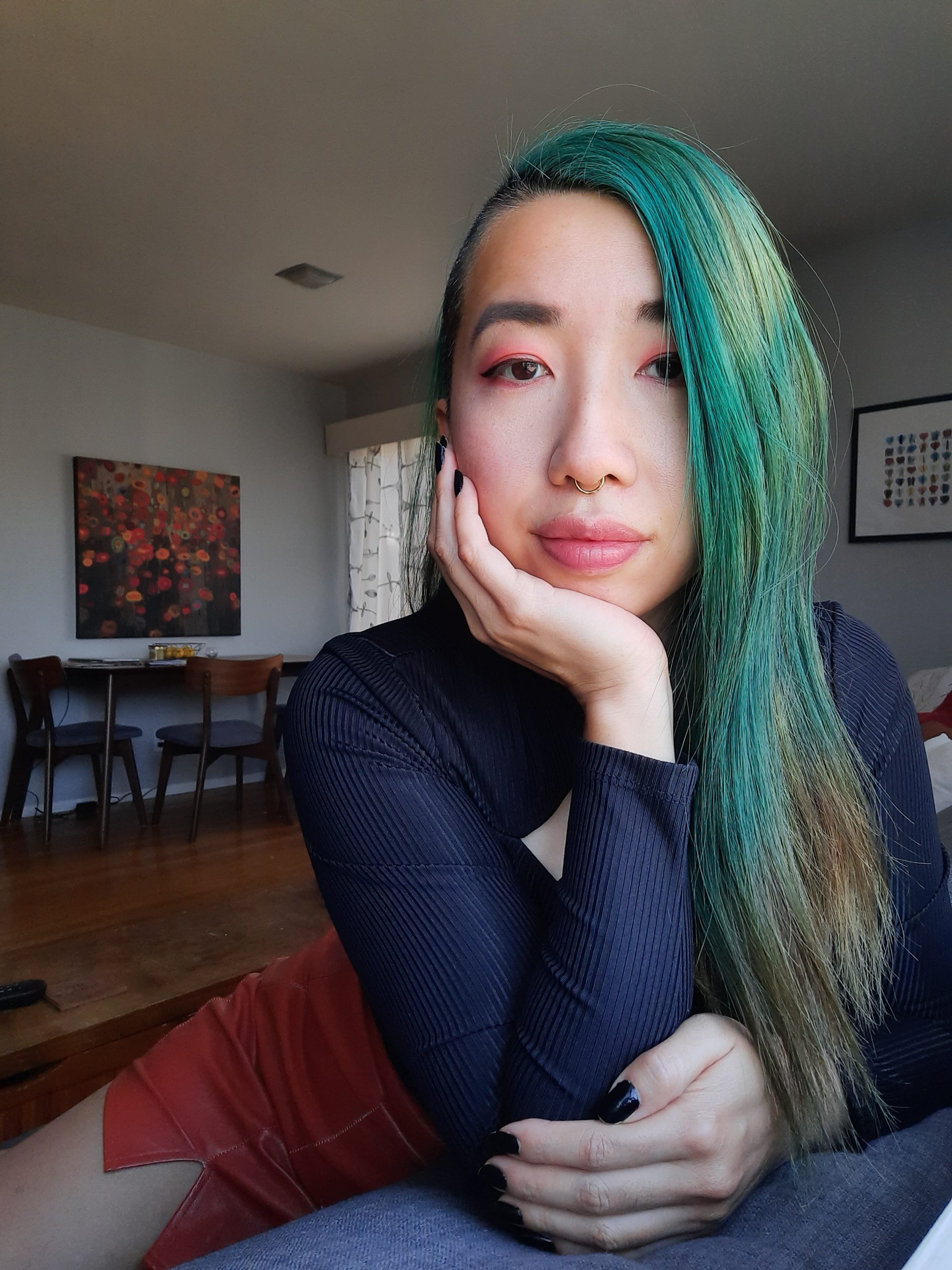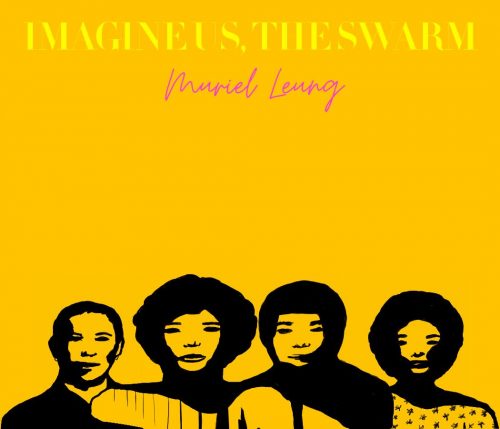Welcome to May We Present…, a column from Lambda Literary that highlights authors with recent or forthcoming publications. This May, we’re presenting (see what I did there?) Muriel Leung and her newest work, Imagine Us, The Swarm, published on May 25th from Nightboat Books. Imagine Us, The Swarm transformed from a single essay too capacious for the limits of the form into an eclectic, genre-bending collection of essays written in verse.
Centering themes of Asian American, queer, and gendered experiences, Imagine Us, The Swarm is as thoughtfully crafted as it is thought-provoking. The collection masterfully brings together Leung’s various artistic influences, including the autobiographical, traditional scholarship, the poetic form, and theory as embodied knowledge.
Below, Muriel Leung shares how she uses grammatical elements to reframe our notions of silence, her favorite podcast-related memory, and some of the many queer BIPOC writers and theorists who keep her inspired.
When did you realize you had to write Imagine Us, The Swarm?
I don’t think I set out to write a book at all. Imagine Us, The Swarm started as an essay that had to be disassembled. I wanted to write about grief, my father’s death and the impact of China’s Cultural Revolution on his life, racialized labor, the inevitable failure of the model minority myth, the inheritance of trauma, and the process of writing as a type of labor too. It was a bloated essay that became more of its true self when I broke it apart, and something new emerged from the white space, the ellipses, the brackets, and the fragments of the text. This would become the opening essay of the book, “This is to live several lives.” I realized that even though the contents of this work spilled out, was overflowing, it was still not the end. And so, I wrote on, realizing I could write a book of these, and then I just kept going until I felt in my heart that I had said all I could say.
Your book makes dynamic use of space: dots fill pages, brackets are left empty, and words remain unsaid. How do you see space functioning in the collection?
The use of grammatical elements, like ellipses and brackets, functions as a way of saying that silence is never just silence. In Imagine Us, The Swarm, the text is guided by voices of gendered Asian American experiences, and so silence, as we collectively know it, is very much racialized and gendered. But silence to whom? I want to reframe this and say, “We were never silent; we were just silenced.” The ellipses and brackets are devices that operate like static, little trickles of noise through what would otherwise be perceived as silence; it is enough to distort the mainstream sentiment, slight as it is, and in this way, it is quietly subversive (or so I hope).
Imagine Us, The Swarm is one of the first published texts I have read that mentions the Coronavirus pandemic. In what ways did the virus influence this work, especially considering that it already engages significantly with broader themes of death and disease?
The essay-in-verse you’re referring to, “The Plural Circuits of Tell,” which appears mid-way through Imagine Us, The Swarm, was originally published in the Jaded Ibis blog with the same title. In this earlier version, there wasn’t any mention of the Coronavirus pandemic because it was 2018, two years before Coronavirus came to the U.S. However, once the manuscript was selected by Nightboat Books for publication, there weren’t really many new edits to this work beyond explicit mention of the virus. In the essay, I wanted to emphasize the connection between the racialization of diseases like the SARS pandemic and xenophobic panic, which is exactly what took place with the Coronavirus—the attribution of a disease to a race of people, such that many would justify violence against Asians because of this racist and xenophobic perception. I could have easily left out explicit mention of Coronavirus and the essay would be just as relevant to what is happening in the years 2020 and 2021. That’s the terrifying part, how the history of racism and xenophobia can continue to accrue power like that if there isn’t an intervention. In short, it was not an essay that began with the racism and xenophobia surrounding the Coronavirus, and it won’t end with it either if we don’t interrogate this violence.
The collection is striking in its blending of the poetic and the academic; it includes footnotes and quotes from other writers. As a Ph.D. student, how does academia, and specifically theory, condition your poetry?
As a Ph.D. candidate in Creative Writing and Literature, I occupy both minds where I’m trained in certain ideas about traditional scholarship, which includes proper citations and footnotes following specified formats, and the constant rule-defying properties of poetry and genre-bending. My artistic process involves a lot of crossing over into multiple territories, and the common goal underlying every piece of work is that it must honor the intellectual and artistic labor of Black women and women of color who came before me and who have directly or indirectly informed my work. Another rule I try to follow is that I don’t replicate certain paradigms of power when I utilize any of these traditions.
I think academic processes, especially when complex theory is concerned, are often considered inaccessible or elitist, but they are only so when the people behind them hoard knowledge and use it to prevent others from accessing them. In truth, I think theory, particularly those that examine the depths and richness of queer, trans, BIPOC, and disabled lives, offer so much to the way we shape our worldview and how we move through the world. I am very much moved by theory in that way, as embodied knowledge and exercise in affinity with those identities that are not mine, but which live in this world with me. This is what sways my art and intellectual pursuits.
The body is quite clearly a site of interest for you in your writing. How do you conceive of the relationship between written language and the material body?
In writing Imagine Us, The Swarm, I kept thinking about the body as oceanic. It probably has something to do with the fact that my parents crossed an ocean to come to the U.S., and there are so many instances of water throughout the book. I suppose I want the writing to feel oceanic too—expansive but also defined by geographic time and place. So, in other words, written language as oceanic text, the material body also as text, wide as water.
You’re the cohost of the podcast The Blood-Jet Radio. What is a favorite podcast-related memory of yours?
I have so many! I loved talking to Sally Wen Mao about her first book, Mad Honey Symposium, and we went on a wonderful tangent where she told me about men feeding her grapes in Greece. I don’t even remember what we were talking about, but I remember thinking, “Oh, we’re going to be friends after this.” There’s also a yet-to-be broadcasted episode that took place during the New Orleans Poetry Festival for a panel entitled “Are We There Yet?” with Ching-In Chen, Tiana Nobile, and Jacquelyn Brown. It was the first time I tried live podcasting, but the opportunity to do a live show somewhere was too hard to pass up. We’re taking a hiatus now but hoping to be more active soon.
Under what circumstance do you feel most creative? What does creativity feel like to you?
I don’t really wait for creativity to magically arrive nor am I someone who does well with a strict writing routine. I am most successful when I think in terms of projects, which allows me to chunk up time, and how much space I can devote to writing. Somehow, if I can see the end, abstract as it can be at times, it allows the constellation of its many pieces to fall into place, and I just work steadily towards it on my own time. I love giving myself prompts, setting up constraints that provide a creative challenge, and even getting feedback on work from close friends sometimes inspires new direction. I love when there’s dynamism and a big open road ahead. The project has to feel possible for the writing to happen.
Who are some queer writers and theorists that keep you inspired?
Wow, there are too many to list here! I’m definitely indebted to queer and trans theorists like José Esteban Muñoz, Dean Spade, Sara Ahmed, Kyla Wazana Tompkins, Mel Y. Chen, Rachel C. Lee, Eve Sedgewick, Karen Tongson, and Riley Snorton. There are also theorists who are creative writers as well like Saretta Morgan, SA Smythe, Vanessa Angélica Villarreal, Vickie Vertiz, Angela Peñaredondo, Joey De Jesus. And those writers who produce theory through their organizing and activism in addition to their literary work like Kay Ulanday Barrett, Leah Lakshmi Piepzna-Samarasinha, Wo Chan, jayy dodd, Dan Lau, and so many more.
Lastly, what’s the one line from Imagine Us, The Swarm that you just can’t get out of your head?
“I surrendered, and I loved them all.”




